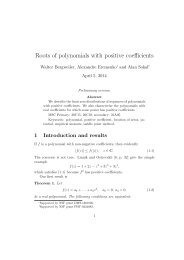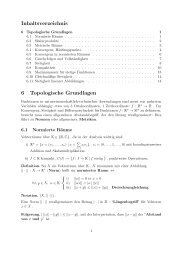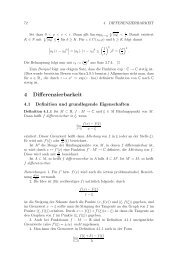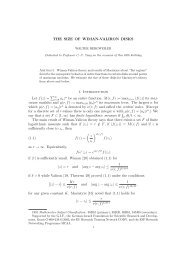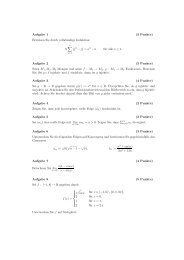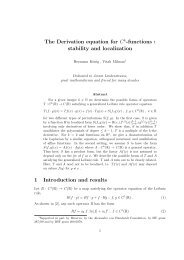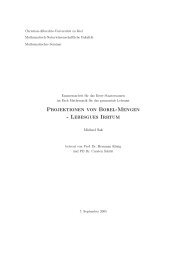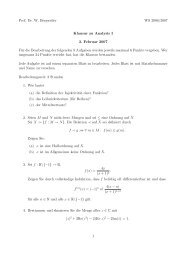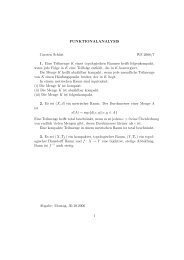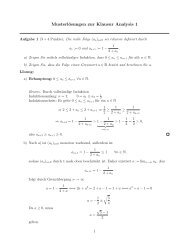Partielle Differentialgleichungen in der Finanzmathematik Vorlesung ...
Partielle Differentialgleichungen in der Finanzmathematik Vorlesung ...
Partielle Differentialgleichungen in der Finanzmathematik Vorlesung ...
Erfolgreiche ePaper selbst erstellen
Machen Sie aus Ihren PDF Publikationen ein blätterbares Flipbook mit unserer einzigartigen Google optimierten e-Paper Software.
5 DIE BLACK-SCHOLES FORMEL 42mit α ′ =√ α2t+ β √ 2t = α+2tβ √2t.Mithilfe von Lemma 5.1 kann nun die Lösung konkret für c(x) := (x − K) + := max{x − K, 0}berechnet werden:∫ ∞ ( x − y + bt)u(t, x) = e ct h t √ (e y − K) + dy√−∞ aa} {{ }Weiter ergibt sichsowieh 1 === e ct ∫ ∞−∞= e ct ∫ α−∞= e (b+c)t · e x ∫ αv:=(h t (v) exp(x + bt − √ ) +av) − K dv} {{ }≥0 ⇐⇒ v≤ x+bt−log(K) √ a=:αh t (v) ( exp(x + bt − √ av) − K ) dv−∞(5.3)= e x e } (b+c)t {{ · e ta} Φ=1 wg. a+b+c=0h t (v) exp(− √ av) dv + e ct K( √ α + 2t a√2t} {{ }h 1 :=)− Ke ct Φ∫ α−∞( α)√2t .}{{}h 2 :=(1 x + bt − log(K)√ √ − 2ta )√ = √ 1 ((2a + b)t + log2t aa 2ta( ex1σ √ t(logh 2 = h 1 − √ 2ta = 1σ √ tK)+) )(r + σ2t .2)((r + σ2t + log2( exKh t (v) dv))− σ √ t = 1 (σ √ logt( )) exK( exK)+) )(r − σ2t2Indem wir die Euler-Transformation (x → e x ), die die allgeme<strong>in</strong>e Black-Scholes Gleichung <strong>in</strong>(5.1) überführt hat, rückgängig machen, erhalten wir so die berühmteBlack-Scholes-Formel. Es bezeichne weiterh<strong>in</strong> r ∈ R >0 den Markt-Z<strong>in</strong>ssatz. Der faire Preise<strong>in</strong>er europäischen Call-Option mit dem Basispreis K auf e<strong>in</strong>e Aktie mit Volatilität σ lautet⎛p(t, x) := x Φ ⎝ log ( ) ) ⎞ ⎛xK +(r + σ22tσ √ ⎠ − Ke −rt Φ ⎝ log ( ) ) ⎞xK +(r − σ22ttσ √ ⎠tbei gegebenem Aktienkurs x ∈ R >0 und Restlaufzeit t ∈ R >0 .Diskussion <strong>der</strong> Black-Scholes-Formel(Zur e<strong>in</strong>facheren Notation setze wie<strong>der</strong> h(t, x) := h 1 (t, x) := 1σ √ log ( ) ) )xt K +(r + σ22t und(h 2 (t, x) := 1σ √ log ( ) ) )xt K +(r − σ22t = h(t, x) − σ √ t. Dann lautet die Black-Scholes-Formelp(t, x) = xΦ(h 1 (t, x)) − e −rt KΦ(h 2 (t, x)).E<strong>in</strong>e nähere Analyse dieser Formel ergibt folgende Beobachtungen:



